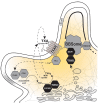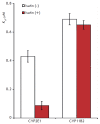Direct Molecular Fishing of New Protein Partners for Human Thromboxane Synthase
- PMID: 29340222
- PMCID: PMC5762833
Direct Molecular Fishing of New Protein Partners for Human Thromboxane Synthase
Abstract
Thromboxane synthase (TBXAS1) catalyzes the isomerization reaction of prostaglandin H2 producing thromboxane A2, the autocrine and paracrine factor in many cell types. A high activity and metastability by these arachidonic acid derivatives suggests the existence of supramolecular structures that are involved in the regulation of the biosynthesis and directed translocation of thromboxane to the receptor. The objective of this study was to identify TBXAS1 protein partners from human liver tissue lysate using a complex approach based on the direct molecular fishing technique, LC-MS/MS protein identification, and protein-protein interaction validation by surface plasmon resonance (SPR). As a result, 12 potential TBXAS1 protein partners were identified, including the components regulating cytoskeleton organization (BBIP1 and ANKMY1), components of the coagulation cascade of human blood (SERPINA1, SERPINA3, APOH, FGA, and FN1), and the enzyme involved in the metabolism of xenobiotics and endogenous bioregulators (CYP2E1). SPR validation on the Biacore 3000 biosensor confirmed the effectiveness of the interaction between CYP2E1 (the enzyme that converts prostaglandin H2 to 12-HHT/thromboxane A2 proantagonist) and TBXAS1 (Kd = (4.3 ± 0.4) × 10-7 M). Importantly, the TBXAS1•CYP2E1 complex formation increases fivefold in the presence of isatin (indole-2,3-dione, a low-molecular nonpeptide endogenous bioregulator, a product of CYP2E1). These results suggest that the interaction between these hemoproteins is important in the regulation of the biosynthesis of eicosanoids.
Keywords: Thromboxane synthase (CYP5A1, TBXAS1); cytochrome P450; direct molecular fishing; isatin; protein partners; surface plasmon resonance.
Figures




References
-
- Waterman M.R., Pikuleva I.A. Encyclopedia of Molecular Cell Biology and Molecular Medicine, Weinheim, Germany: Wiley-VCH., 2006. 716 p. 2006.
-
- Haurand M., Ullrich V.. J. Biol. Chem. 1985;260:15059–15067. - PubMed
-
- Uchida K.. Trends Cardiovasc. Med. 1999;9(5):109–113. - PubMed
-
- Chaudhary A.K., Nokubo M., Reddy G.R., Yeola S.N., Morrow J.D., Blair I.A., Marnett L.J.. Science. 1994;265(5178):1580–1582. - PubMed
LinkOut - more resources
Full Text Sources
Research Materials
Miscellaneous
